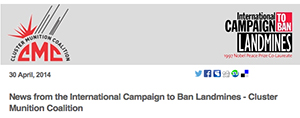14 November 2011
ICBL statement at the CCW Amended Protocol II conference
On 11 November, Steve Goose - Chair of the International Campaign to Ban Landmines delivered the following statement at the 13th Annual Conference of Amended Protocol II, Convention on Conventional Weapons in Geneva, Switzerland
Thank you for the floor Mr. President. We appreciate the range of work still being done on Amended Protocol II, but we cannot help but note that little of it is specific to antipersonnel landmines. That is because, for antipersonnel mines, the protocol is largely irrelevant – irrelevant due to the overwhelming success of the Mine Ban Treaty that comprehensively bans the weapon.
At best, for antipersonnel mines, the protocol is only relevant to the 11 Amended Protocol II States Parties that have not yet joined the Mine Ban Treaty. All other States Parties are bound by the much higher standards of the Mine Ban Treaty. And in fact, most of the 11 are acting in de facto compliance with the Mine Ban Treaty – not using, producing, or exporting antipersonnel mines. This is a reflection of the powerful stigma against the weapon created by the Mine Ban Treaty, and a reflection of the new international norm being established by the Mine Ban Treaty completely rejecting antipersonnel mines.
We invite those CCW States Parties that have not yet joined the Mine Ban Treaty to do so as soon as possible. We note that Finland has committed to do so next year, and we congratulate Finland for that and very much look forward to welcoming it to the mine ban community. We also note that the United States is still in the midst of a review of its landmine policy and examining the possibility of acceding to the Mine Ban Treaty. It is also worth noting that lessons can be learned from the relationship of Amended Protocol II and the Mine Ban Treaty.
Those promoting a Protocol VI on cluster munitions should recognize that it will only be relevant for a small number of countries, and that even for that small number, the stigma against cluster munitions and the international standard of behavior being created by the Convention on Cluster Munitions will be more powerful than the protocol.
In a disturbing development, one Amended Protocol II State Party – Israel – newly used antipersonnel mines during the past year. To our knowledge, this is the first confirmed new use by Israel in many years. It is one of the very few instances of new use by Amended Protocol II states in recent years. In August 2011, the journal of the Israel Defense Force (IDF) reported that IDF soldiers were planting antipersonnel mines in the Golan Heights along the border with Syria. It was reported that the mines were laid openly and in daylight by Combat Engineering Corps officer cadets and placed beyond the border security fence, but within the “Alpha Line” that marks the border with Syria. The mines were reportedly laid after hundreds of civilians entered Israeli territory in May 2011, during an annual Palestinian commemoration, apparently crossing through minefields uninjured.
The ICBL publicly condemned this mine use by the IDF, and the President of the 10th Meeting of States Parties to the Mine Ban Treaty expressed his deep concern. I believe that the Israeli delegate in her general remarks earlier was making a vague reference to this new use when speaking of the need to defend borders with antipersonnel mines. But it would seem appropriate for Israel to share details with other States Parties about its new deployment of mines and measures taken to comply with Amended Protocol II, including steps taken to ensure the effective exclusion of civilians from the areas, as required by Article 5.2.
The fact that no other State Party has remarked upon the new Israeli use is also telling. As alluded to by the ICRC, transparency and accountability have been sorely lacking throughout the life of Amended Protocol II. This is another factor to consider when assessing the possible impact and desirability of a future Protocol VI on cluster munitions.
Thank you.


